Electrical and Electronic Principles TMA 3: Waveforms & Transients
VerifiedAdded on 2022/09/14
|26
|1243
|15
Homework Assignment
AI Summary
This document presents a comprehensive solution to the Electrical and Electronic Principles (EEP) TMA 3 assignment, focusing on complex waveforms and transients in R-L-C circuits. The solution addresses multiple questions, including analyzing even and odd functions, half-wave symmetry, and applying Fourier series. It covers calculating RMS values, harmonic content, and the effects of asymmetrical waveforms. The assignment also involves the application of Fourier transforms and the synthesis of waveforms from their principal harmonics. Furthermore, it delves into transient responses in R-L-C circuits, including calculations of settling time and the use of Laplace transforms to analyze circuit behavior. The solution provides detailed steps and explanations for each problem, demonstrating a strong understanding of electrical engineering principles.
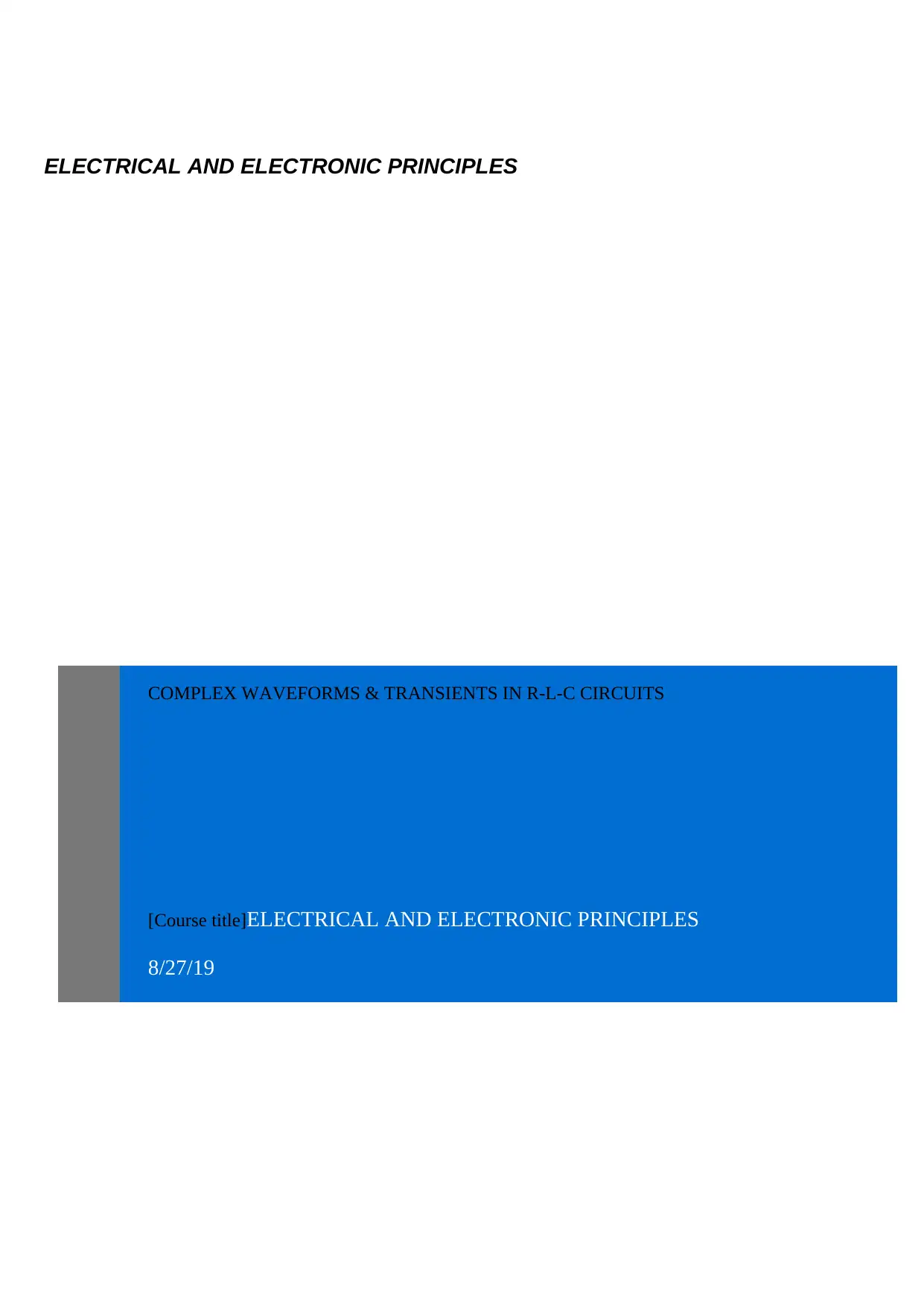
COMPLEX WAVEFORMS & TRANSIENTS IN R-L-C CIRCUITS
[Course title]ELECTRICAL AND ELECTRONIC PRINCIPLES
8/27/19
ELECTRICAL AND ELECTRONIC PRINCIPLES
[Course title]ELECTRICAL AND ELECTRONIC PRINCIPLES
8/27/19
ELECTRICAL AND ELECTRONIC PRINCIPLES
Paraphrase This Document
Need a fresh take? Get an instant paraphrase of this document with our AI Paraphraser
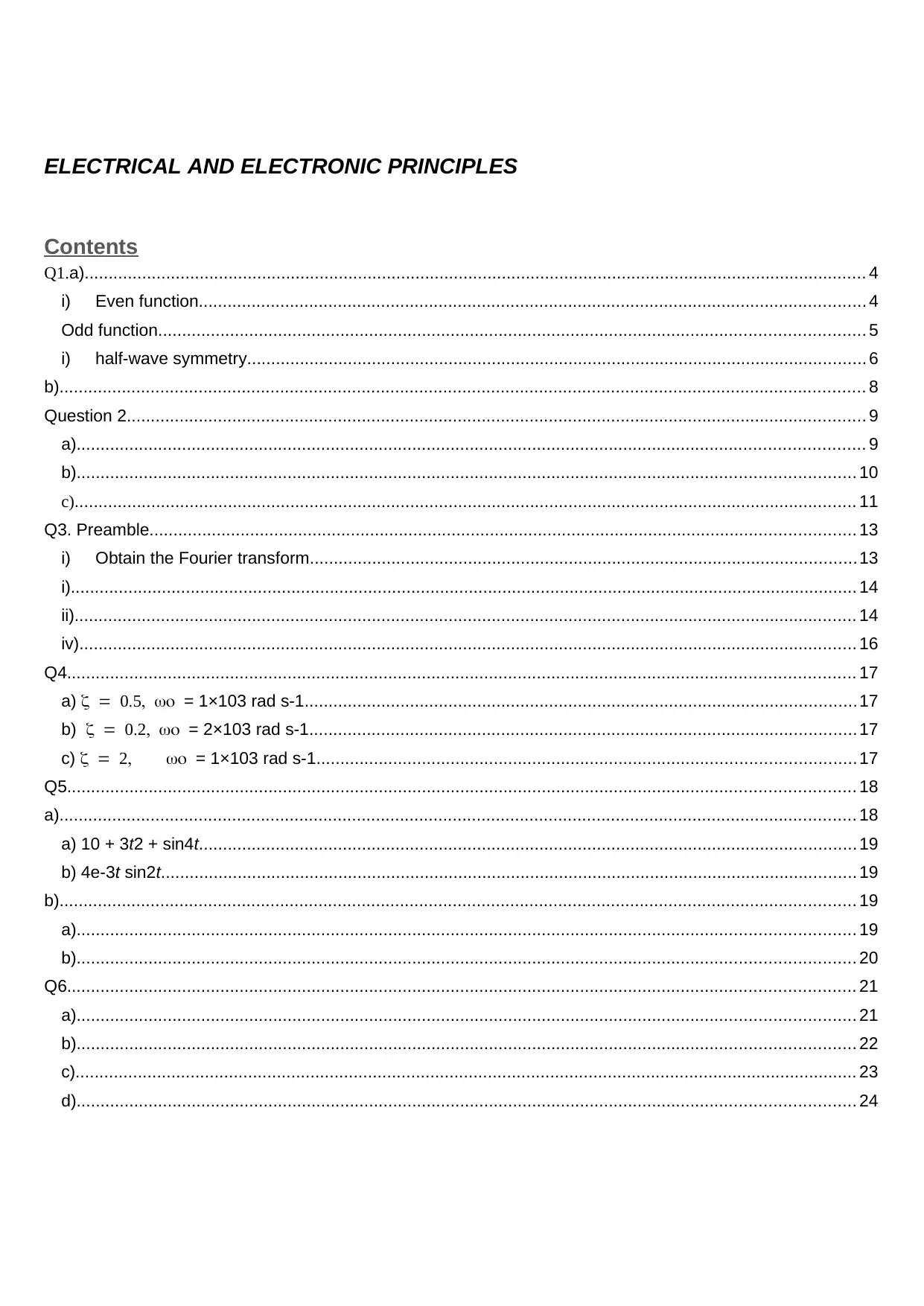
ELECTRICAL AND ELECTRONIC PRINCIPLES
Contents
Q1.a)................................................................................................................................................................... 4
i) Even function........................................................................................................................................... 4
Odd function................................................................................................................................................... 5
i) half-wave symmetry................................................................................................................................. 6
b)........................................................................................................................................................................ 8
Question 2.......................................................................................................................................................... 9
a).................................................................................................................................................................... 9
b).................................................................................................................................................................. 10
c)................................................................................................................................................................... 11
Q3. Preamble................................................................................................................................................... 13
i) Obtain the Fourier transform..................................................................................................................13
i).................................................................................................................................................................... 14
ii)................................................................................................................................................................... 14
iv).................................................................................................................................................................. 16
Q4.................................................................................................................................................................... 17
a) = 1×103 rad s-1...................................................................................................................17
b) = 2×103 rad s-1.................................................................................................................. 17
c) = 1×103 rad s-1................................................................................................................ 17
Q5.................................................................................................................................................................... 18
a)...................................................................................................................................................................... 18
a) 10 + 3t2 + sin4t......................................................................................................................................... 19
b) 4e-3t sin2t................................................................................................................................................. 19
b)...................................................................................................................................................................... 19
a).................................................................................................................................................................. 19
b).................................................................................................................................................................. 20
Q6.................................................................................................................................................................... 21
a).................................................................................................................................................................. 21
b).................................................................................................................................................................. 22
c)................................................................................................................................................................... 23
d).................................................................................................................................................................. 24
Contents
Q1.a)................................................................................................................................................................... 4
i) Even function........................................................................................................................................... 4
Odd function................................................................................................................................................... 5
i) half-wave symmetry................................................................................................................................. 6
b)........................................................................................................................................................................ 8
Question 2.......................................................................................................................................................... 9
a).................................................................................................................................................................... 9
b).................................................................................................................................................................. 10
c)................................................................................................................................................................... 11
Q3. Preamble................................................................................................................................................... 13
i) Obtain the Fourier transform..................................................................................................................13
i).................................................................................................................................................................... 14
ii)................................................................................................................................................................... 14
iv).................................................................................................................................................................. 16
Q4.................................................................................................................................................................... 17
a) = 1×103 rad s-1...................................................................................................................17
b) = 2×103 rad s-1.................................................................................................................. 17
c) = 1×103 rad s-1................................................................................................................ 17
Q5.................................................................................................................................................................... 18
a)...................................................................................................................................................................... 18
a) 10 + 3t2 + sin4t......................................................................................................................................... 19
b) 4e-3t sin2t................................................................................................................................................. 19
b)...................................................................................................................................................................... 19
a).................................................................................................................................................................. 19
b).................................................................................................................................................................. 20
Q6.................................................................................................................................................................... 21
a).................................................................................................................................................................. 21
b).................................................................................................................................................................. 22
c)................................................................................................................................................................... 23
d).................................................................................................................................................................. 24

ELECTRICAL AND ELECTRONIC PRINCIPLES
⊘ This is a preview!⊘
Do you want full access?
Subscribe today to unlock all pages.

Trusted by 1+ million students worldwide
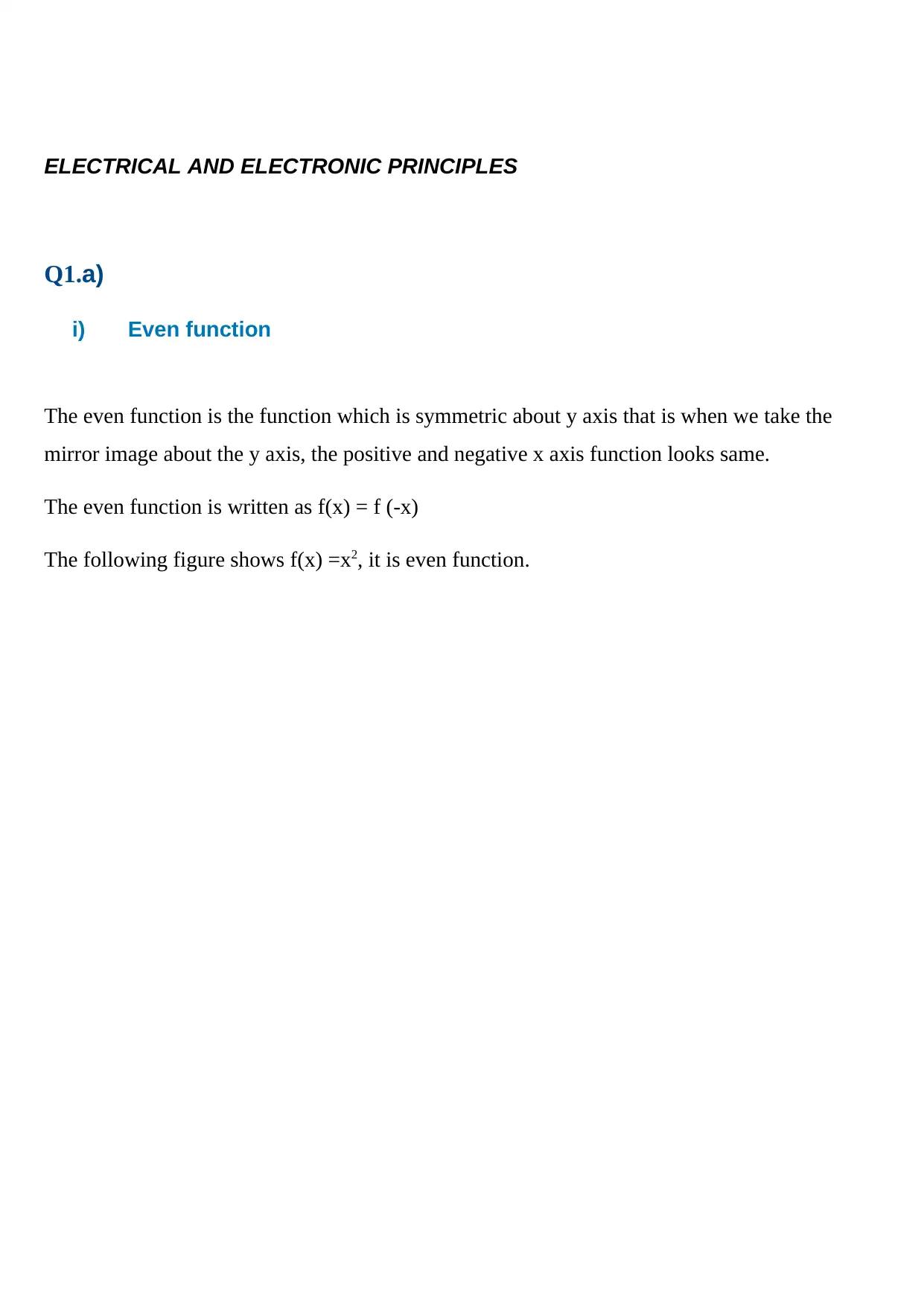
ELECTRICAL AND ELECTRONIC PRINCIPLES
Q1.a)
i) Even function
The even function is the function which is symmetric about y axis that is when we take the
mirror image about the y axis, the positive and negative x axis function looks same.
The even function is written as f(x) = f (-x)
The following figure shows f(x) =x2, it is even function.
Q1.a)
i) Even function
The even function is the function which is symmetric about y axis that is when we take the
mirror image about the y axis, the positive and negative x axis function looks same.
The even function is written as f(x) = f (-x)
The following figure shows f(x) =x2, it is even function.
Paraphrase This Document
Need a fresh take? Get an instant paraphrase of this document with our AI Paraphraser
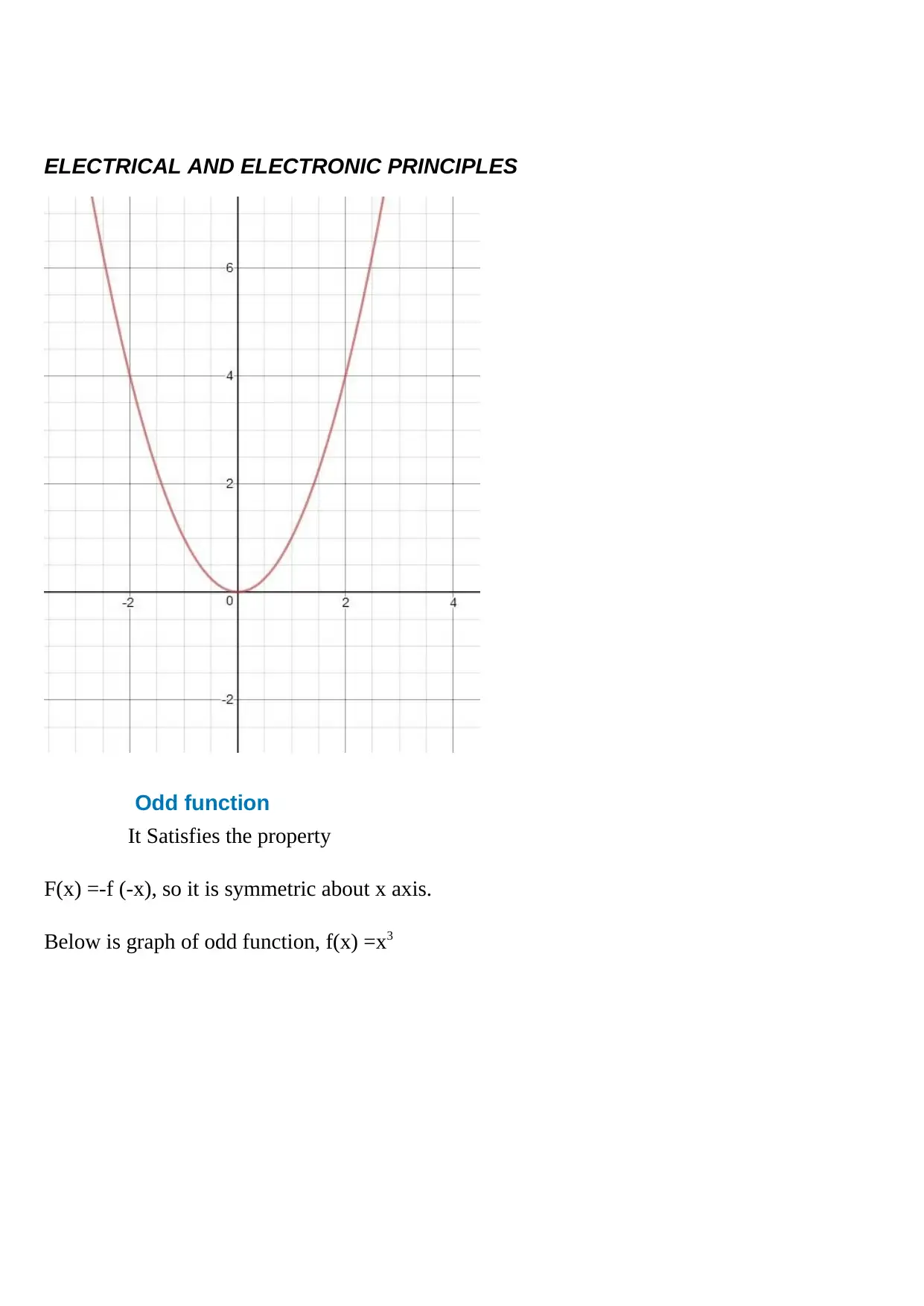
ELECTRICAL AND ELECTRONIC PRINCIPLES
Odd function
It Satisfies the property
F(x) =-f (-x), so it is symmetric about x axis.
Below is graph of odd function, f(x) =x3
Odd function
It Satisfies the property
F(x) =-f (-x), so it is symmetric about x axis.
Below is graph of odd function, f(x) =x3
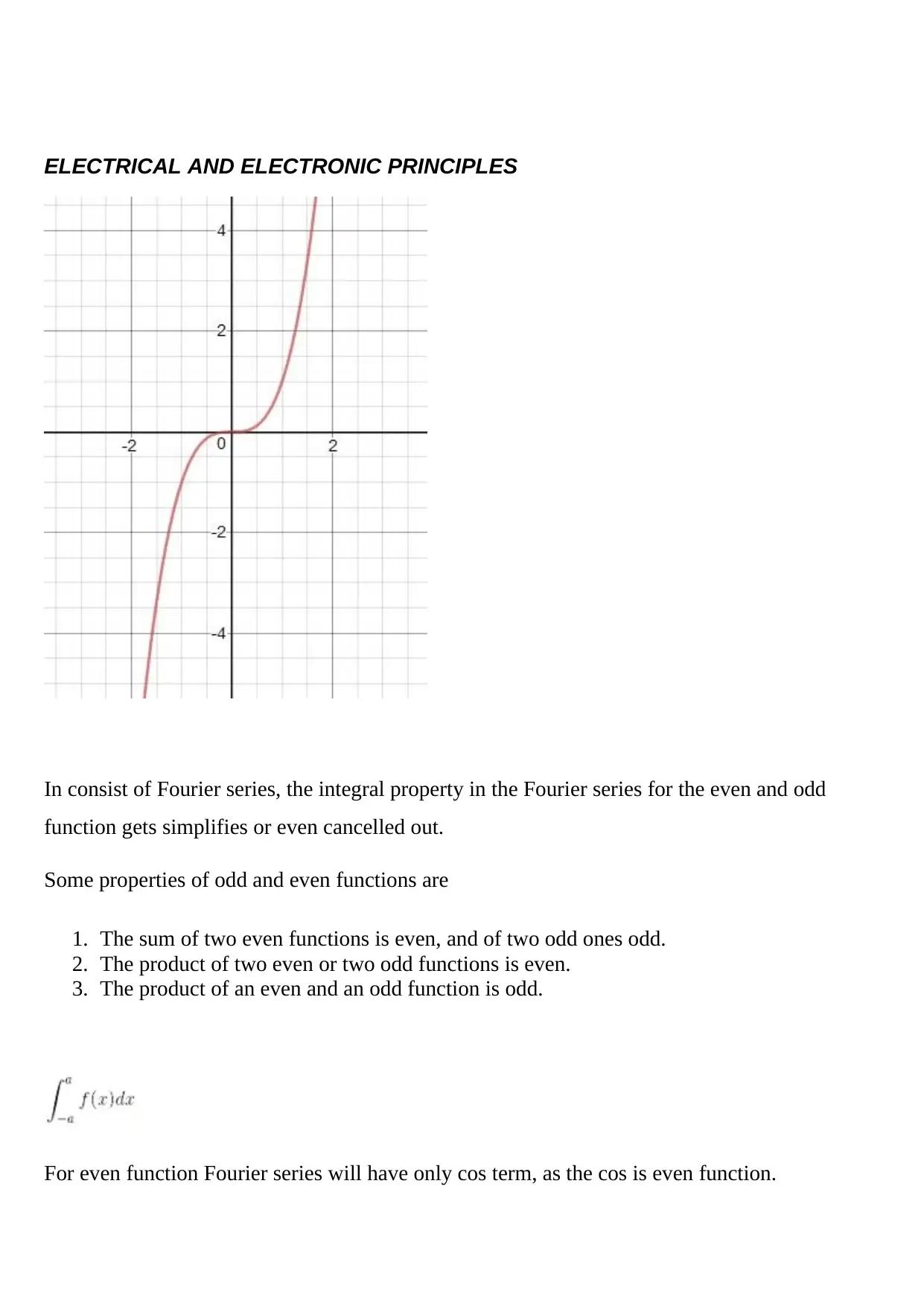
ELECTRICAL AND ELECTRONIC PRINCIPLES
In consist of Fourier series, the integral property in the Fourier series for the even and odd
function gets simplifies or even cancelled out.
Some properties of odd and even functions are
1. The sum of two even functions is even, and of two odd ones odd.
2. The product of two even or two odd functions is even.
3. The product of an even and an odd function is odd.
For even function Fourier series will have only cos term, as the cos is even function.
In consist of Fourier series, the integral property in the Fourier series for the even and odd
function gets simplifies or even cancelled out.
Some properties of odd and even functions are
1. The sum of two even functions is even, and of two odd ones odd.
2. The product of two even or two odd functions is even.
3. The product of an even and an odd function is odd.
For even function Fourier series will have only cos term, as the cos is even function.
⊘ This is a preview!⊘
Do you want full access?
Subscribe today to unlock all pages.

Trusted by 1+ million students worldwide
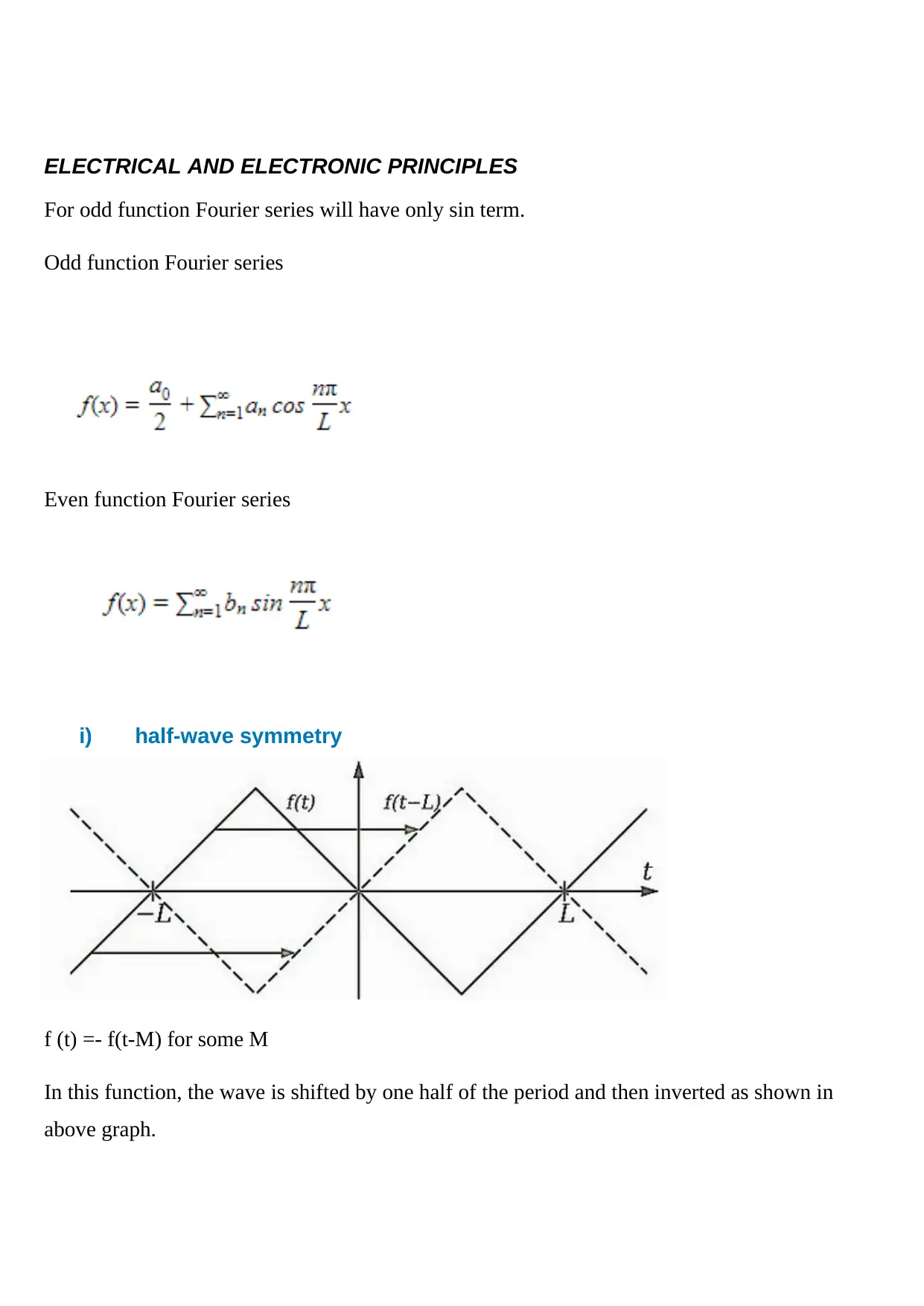
ELECTRICAL AND ELECTRONIC PRINCIPLES
For odd function Fourier series will have only sin term.
Odd function Fourier series
Even function Fourier series
i) half-wave symmetry
f (t) =- f(t-M) for some M
In this function, the wave is shifted by one half of the period and then inverted as shown in
above graph.
For odd function Fourier series will have only sin term.
Odd function Fourier series
Even function Fourier series
i) half-wave symmetry
f (t) =- f(t-M) for some M
In this function, the wave is shifted by one half of the period and then inverted as shown in
above graph.
Paraphrase This Document
Need a fresh take? Get an instant paraphrase of this document with our AI Paraphraser
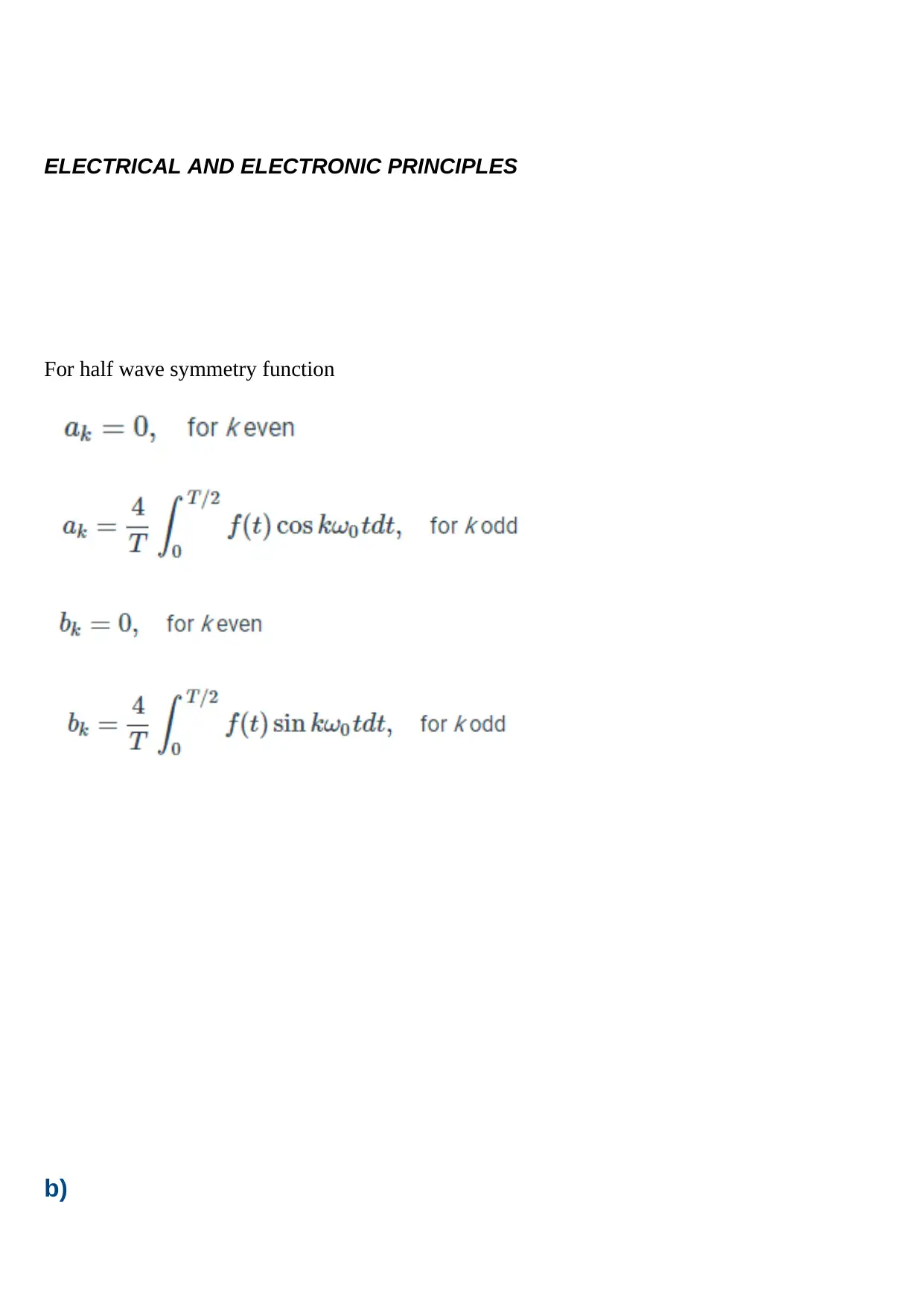
ELECTRICAL AND ELECTRONIC PRINCIPLES
For half wave symmetry function
b)
For half wave symmetry function
b)
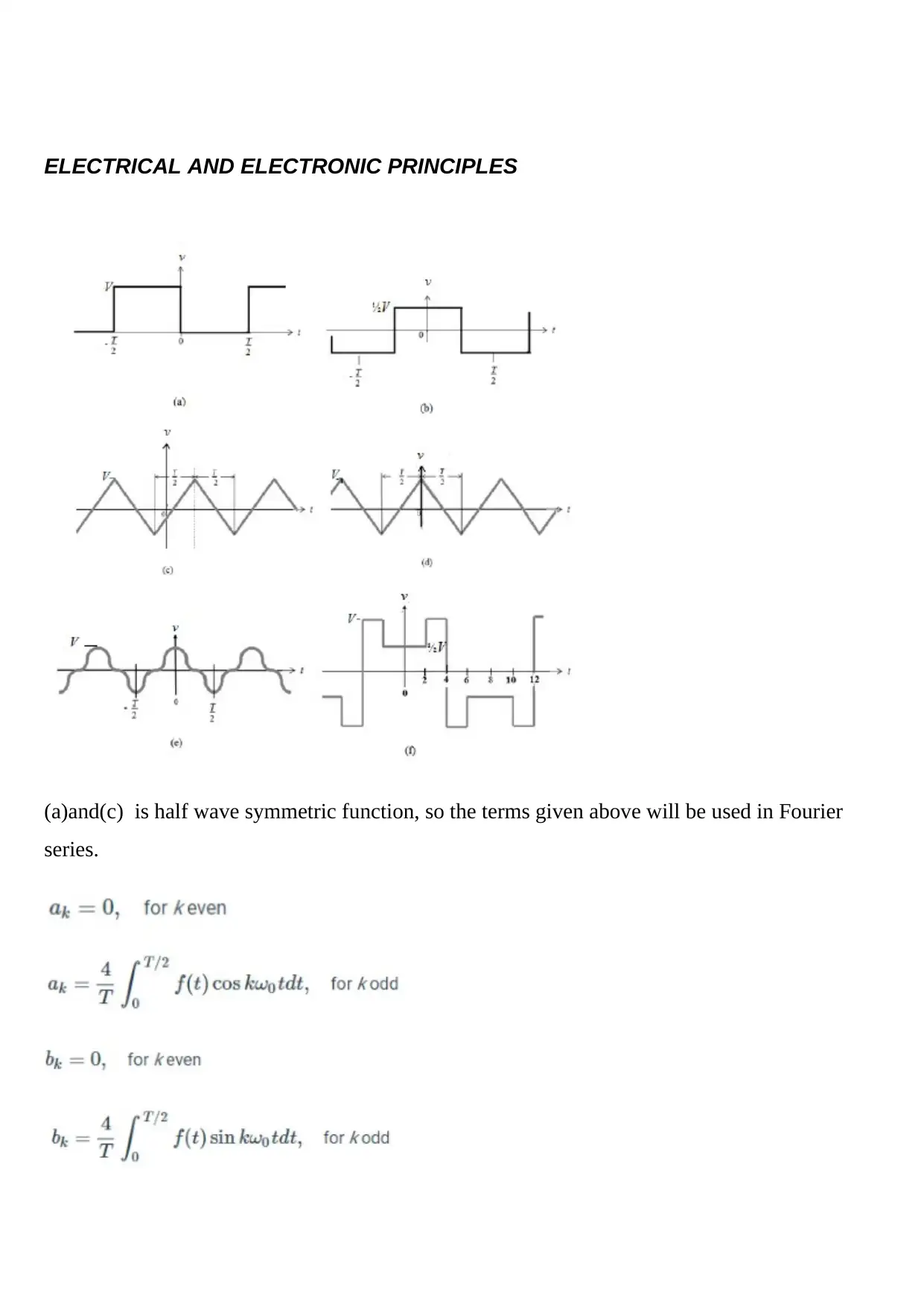
ELECTRICAL AND ELECTRONIC PRINCIPLES
(a)and(c) is half wave symmetric function, so the terms given above will be used in Fourier
series.
(a)and(c) is half wave symmetric function, so the terms given above will be used in Fourier
series.
⊘ This is a preview!⊘
Do you want full access?
Subscribe today to unlock all pages.

Trusted by 1+ million students worldwide
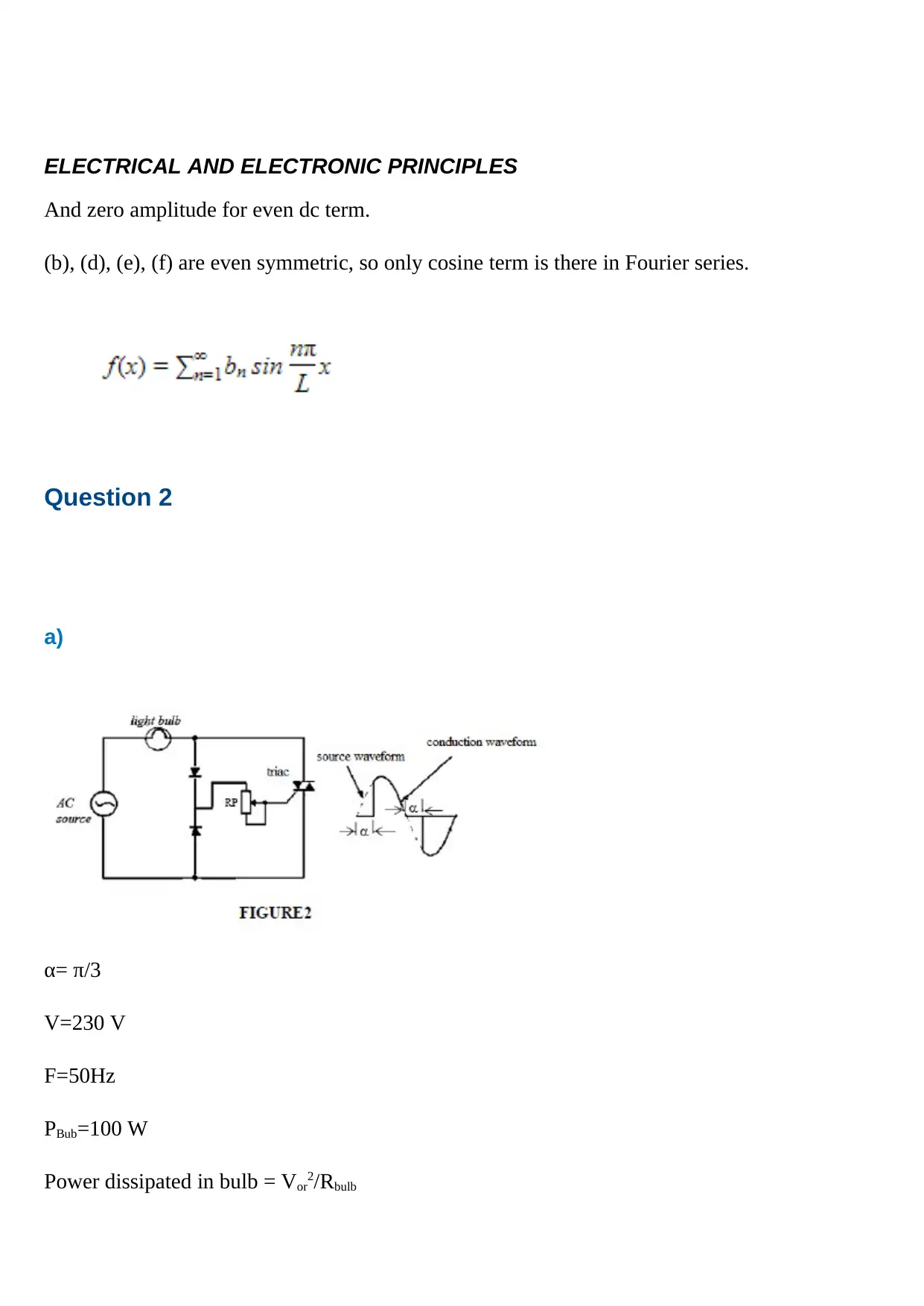
ELECTRICAL AND ELECTRONIC PRINCIPLES
And zero amplitude for even dc term.
(b), (d), (e), (f) are even symmetric, so only cosine term is there in Fourier series.
Question 2
a)
α= π/3
V=230 V
F=50Hz
PBub=100 W
Power dissipated in bulb = Vor2/Rbulb
And zero amplitude for even dc term.
(b), (d), (e), (f) are even symmetric, so only cosine term is there in Fourier series.
Question 2
a)
α= π/3
V=230 V
F=50Hz
PBub=100 W
Power dissipated in bulb = Vor2/Rbulb
Paraphrase This Document
Need a fresh take? Get an instant paraphrase of this document with our AI Paraphraser
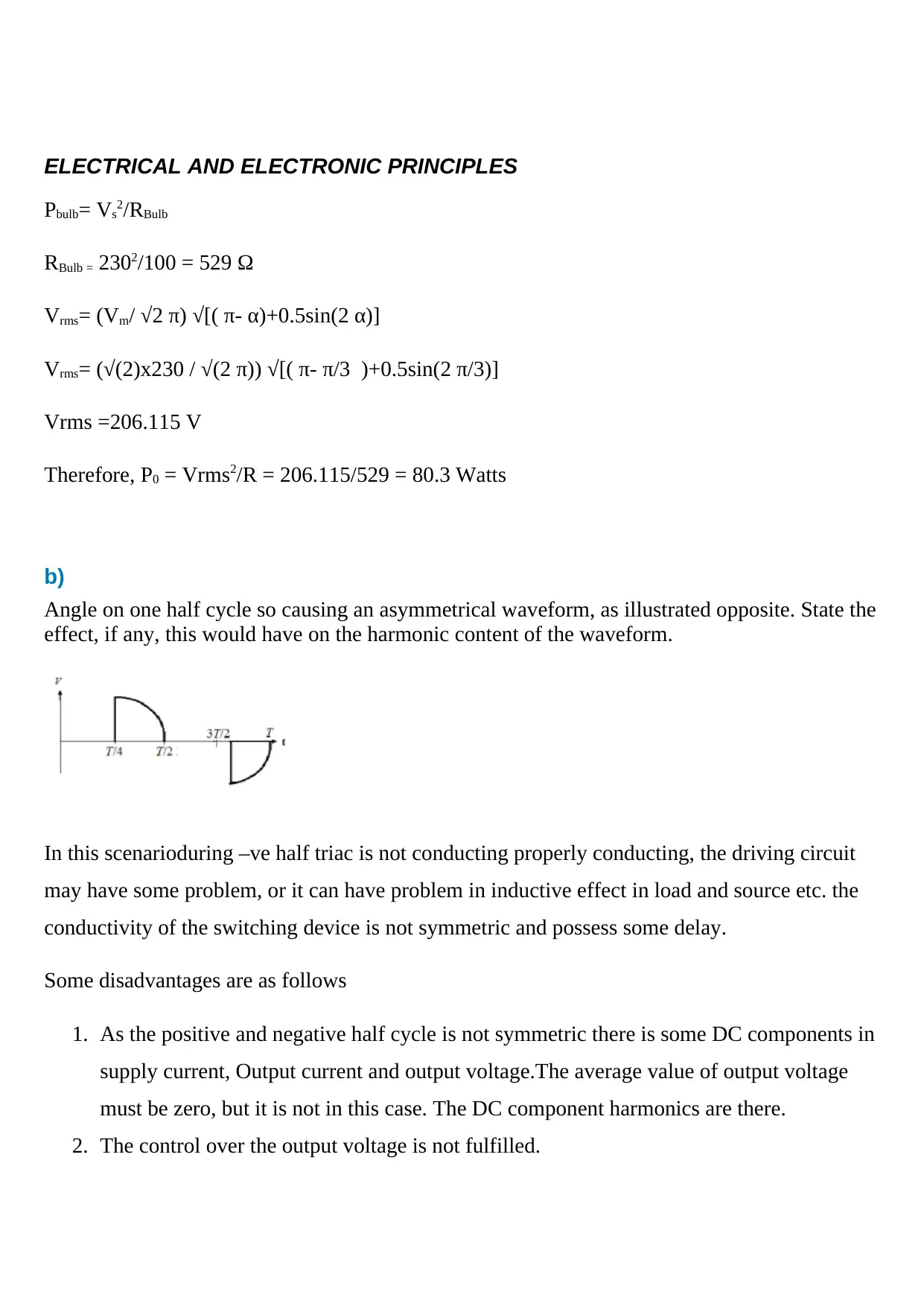
ELECTRICAL AND ELECTRONIC PRINCIPLES
Pbulb= Vs2/RBulb
RBulb = 2302/100 = 529 Ω
Vrms= (Vm/ √2 π) √[( π- α)+0.5sin(2 α)]
Vrms= (√(2)x230 / √(2 π)) √[( π- π/3 )+0.5sin(2 π/3)]
Vrms =206.115 V
Therefore, P0 = Vrms2/R = 206.115/529 = 80.3 Watts
b)
Angle on one half cycle so causing an asymmetrical waveform, as illustrated opposite. State the
effect, if any, this would have on the harmonic content of the waveform.
In this scenarioduring –ve half triac is not conducting properly conducting, the driving circuit
may have some problem, or it can have problem in inductive effect in load and source etc. the
conductivity of the switching device is not symmetric and possess some delay.
Some disadvantages are as follows
1. As the positive and negative half cycle is not symmetric there is some DC components in
supply current, Output current and output voltage.The average value of output voltage
must be zero, but it is not in this case. The DC component harmonics are there.
2. The control over the output voltage is not fulfilled.
Pbulb= Vs2/RBulb
RBulb = 2302/100 = 529 Ω
Vrms= (Vm/ √2 π) √[( π- α)+0.5sin(2 α)]
Vrms= (√(2)x230 / √(2 π)) √[( π- π/3 )+0.5sin(2 π/3)]
Vrms =206.115 V
Therefore, P0 = Vrms2/R = 206.115/529 = 80.3 Watts
b)
Angle on one half cycle so causing an asymmetrical waveform, as illustrated opposite. State the
effect, if any, this would have on the harmonic content of the waveform.
In this scenarioduring –ve half triac is not conducting properly conducting, the driving circuit
may have some problem, or it can have problem in inductive effect in load and source etc. the
conductivity of the switching device is not symmetric and possess some delay.
Some disadvantages are as follows
1. As the positive and negative half cycle is not symmetric there is some DC components in
supply current, Output current and output voltage.The average value of output voltage
must be zero, but it is not in this case. The DC component harmonics are there.
2. The control over the output voltage is not fulfilled.
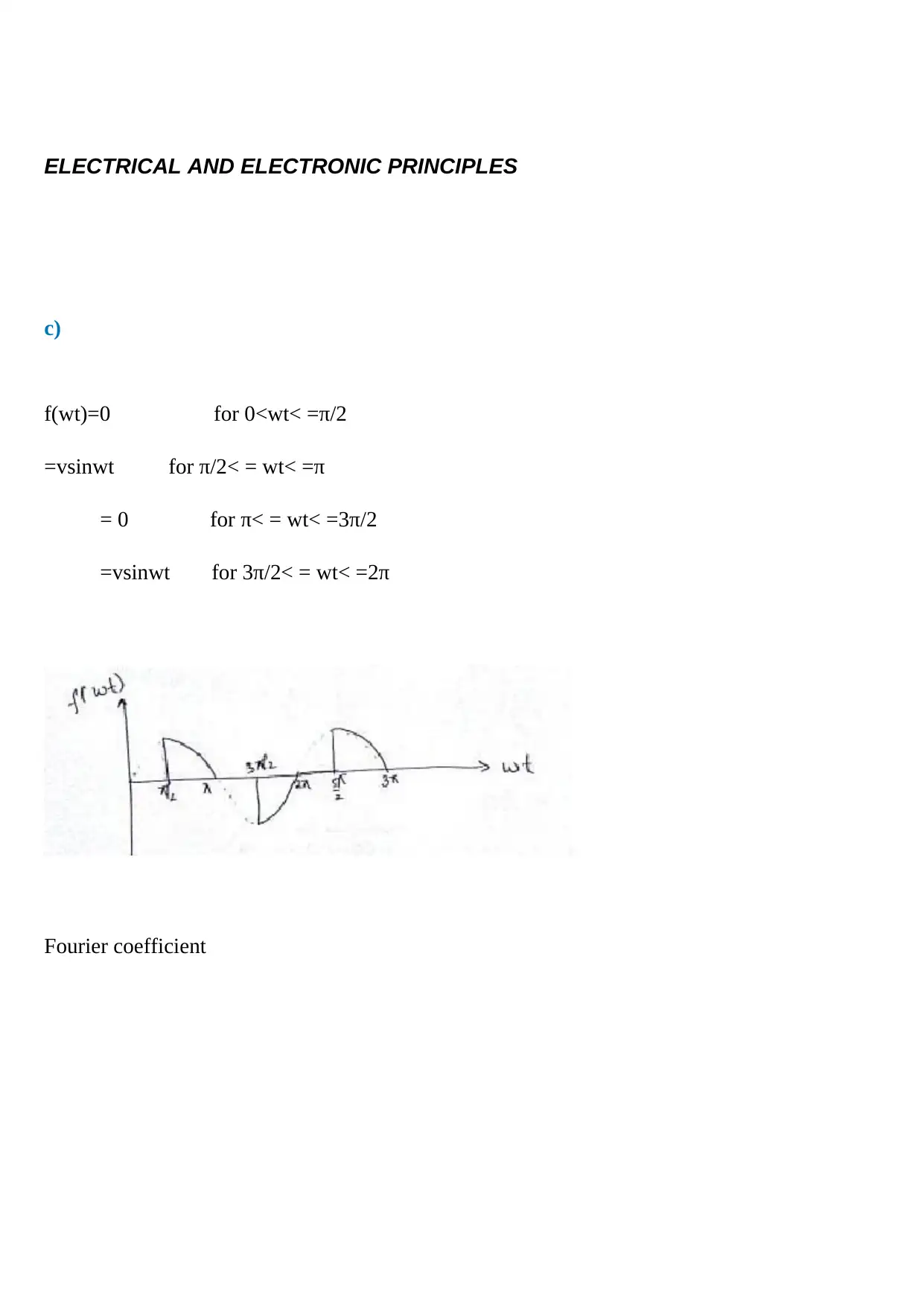
ELECTRICAL AND ELECTRONIC PRINCIPLES
c)
f(wt)=0 for 0<wt< =π/2
=vsinwt for π/2< = wt< =π
= 0 for π< = wt< =3π/2
=vsinwt for 3π/2< = wt< =2π
Fourier coefficient
c)
f(wt)=0 for 0<wt< =π/2
=vsinwt for π/2< = wt< =π
= 0 for π< = wt< =3π/2
=vsinwt for 3π/2< = wt< =2π
Fourier coefficient
⊘ This is a preview!⊘
Do you want full access?
Subscribe today to unlock all pages.

Trusted by 1+ million students worldwide
1 out of 26
Related Documents
Your All-in-One AI-Powered Toolkit for Academic Success.
+13062052269
info@desklib.com
Available 24*7 on WhatsApp / Email
![[object Object]](/_next/static/media/star-bottom.7253800d.svg)
Unlock your academic potential
Copyright © 2020–2025 A2Z Services. All Rights Reserved. Developed and managed by ZUCOL.




